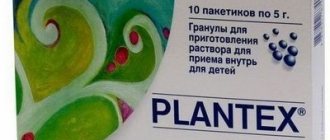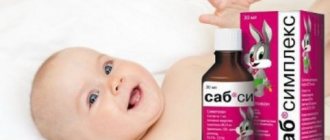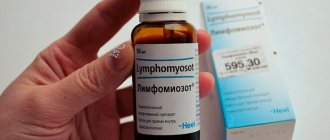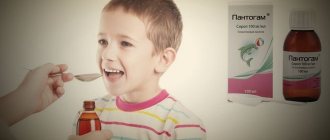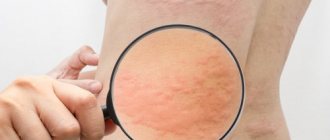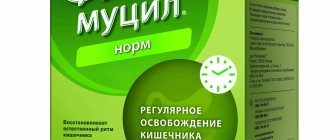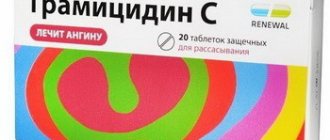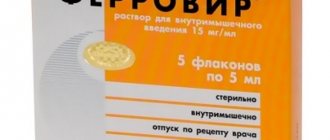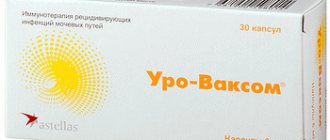Espumisan drops are a remedy that eliminates the processes of increased gas formation in the intestines of young children. The drug rarely causes side effects and goes well with the simultaneous use of other drugs. Before use, you must consult a doctor, as it cannot be used for intestinal obstruction, which is also accompanied by flatulence.
Pharmacodynamics and pharmacokinetics
Pharmacodynamics
The mechanism of action of simethicone is based on reducing the surface tension of gas bubbles formed in the intestines, which leads to their rupture. Simethicone acts on the surface of gas bubbles without affecting the mucous membrane and is not absorbed, therefore it is harmless to the child’s body. The released gas is removed from the intestines naturally, while digestion is normalized and nutrients are better absorbed.
The drug does not affect gastric secretion. There is no habituation to it. In terms of pharmacological treatment, colic is considered one of the most effective carminatives. Prescribed during the onset of pain (pain disappears within 10 minutes) or for the purpose of prevention with each feeding.
Pharmacokinetics
After oral administration, it is not absorbed from the intestine and is excreted unchanged.
Side effects, interactions with other drugs
The manufacturer indicates that no negative effects on the body have been established when Espumisan is used simultaneously with other medications. Drops are often used in the complex treatment of poisoning and intoxication, as they eliminate excess gas formation, improving the absorption of other medications in the treatment of intestinal pathologies.
Read more Indomethacin eye drops: instructions for use and reviews
Side effects are extremely rare, since the drug does not have a systemic effect. Only individual intolerance to the components in the drops is possible, manifested by the occurrence of an allergic reaction in the form of itching or rash.
Instructions for use of Espumisan Baby drops
Children's Espumisan is a drug in drops in bottles with a dropper, with which you can accurately dose the drops by holding the bottle vertically with the pipette down. Remember that the bottle is shaken before use.
Instructions for Espumisan for newborns
How many drops to give to a newborn? Give 5-10 drops during each feeding or after, but no more than 5 times a day.
How to take Espumisan for newborns? The drug is given from a spoon; if that doesn’t work, you can add it to a bottle of water or formula. To avoid negative consequences, you cannot prescribe the drug to your child on your own, but only on the recommendation of a pediatrician. It can exclude a pathology such as intestinal obstruction, in which the drug is contraindicated. This medicine is effective for increased gas formation that occurs during the period of adaptation of the digestive system, which is still imperfect in infants. Since not enough enzymes are produced, gas formation is inevitable.
Instructions for use for older children: the drug is given to children from 1 to 6 years old, 10 drops up to 5 times a day, over 6 years old - 20 drops up to 5 times. If you do not find Espumisan Baby in the pharmacy, you can use Espumisan 40 or Espumisan L, however, the dose will be higher, since these drugs contain 8 mg and 40 mg of simethicone in 1 ml, respectively, and not 100 mg. Newborns and children up to one year old are given 1 measuring spoon (or 25 drops) during each feeding, children from 6 years old 2 measuring spoons (or 50 drops) up to 5 times a day. Any drug can be taken long-term.
Release form, composition
Espumisan baby drops are a slightly viscous milky-white emulsion with a pleasant banana smell. A dark glass bottle contains 30 ml of the drug with a dropper dispenser. The cardboard package contains 1 bottle, 1 measuring cap, instructions.
The main active component of the drops is simethicone. Additionally, the composition includes:
- purified water;
- banana flavor;
- sodium chloride;
- liquid non-crystallizing sorbitol;
- acesulfame potassium;
- sorbic acid;
- glyceryl monostearate 40 – 55;
- carbomer;
- macrogol stearate 40.
The additional components of the drops do not have a pronounced therapeutic effect.
Analogs
Level 4 ATC code matches:
Disflatil
Mint tablets
Kuplaton
Espumisan
Espumisan L
Espumisan 40
Bobotik
Dill water
Pepsan-R
Sub Simplex
Infacol
Plantex
Bebinos
Dicetel
Meteospasmil
Romazulan
An analogue for children based on simethicone is Bobotik , Sab Simlex , containing essential oils - Baby Calm and Happy Baby , granules from plant raw materials Plantex .
Bobotik is approved for children from 28 days of age, contains raspberry flavor and citric acid, and does not contain milk sugar.
Simplex suspension is used from birth. The suspension is not viscous, separates and requires careful shaking. Should be used with caution in children prone to allergic reactions. Espumisan for children is also used from birth, but the emulsion is more viscous in consistency compared to the suspension.
What is better Plantex or Espumisan for newborns?
These are drugs with different active ingredients. Plantex are granules for making tea, containing fennel fruit extract. It has a carminative effect (prevents the formation of gases), improves digestion, eliminates spasms. It can be given to newborns from 2 weeks of age as a drink. Diluted tea does not change its properties during the day. The drug contains lactose, so tea should not be given to children with lactase deficiency. Pediatricians note that children are often allergic to the drug. Parents also report this in their reviews.
What is better than Espumisan for children? First of all, it is physiologically inert, not absorbed, and does not contain lactose. It can be used for a long time without fear of addiction and the appearance of any side effects.
Storage conditions
The drug can be stored at room temperature if it does not exceed 25 degrees.
The drops are placed in a dark glass bottle, but it is better to keep them away from sunlight. To do this, after use, simply place the bottle back into the cardboard box in which it was sold.
The shelf life of the drops is 3 years, but an open bottle is best used within a month.
Colic in babies usually appears in the 2nd week of life and goes away on its own by about six months, when the baby’s digestive system adapts to food intake.
But why stoically endure this discomfort when the first months of life can not be overshadowed by the constant struggle with flatulence in a small tummy. Espumisan baby is an absolutely safe but effective way to restore peace of mind to both the baby and his parents.
Reviews
Infantile colic begins to bother the child at 2–3 weeks of life and continues until 3–6 months. To eliminate them, there is children's Espumisan. Questions often arise: can it be given to a newborn and how to give it to an infant? Let's look at these questions. A child under 28 days of age is considered a newborn. Espumisan L and Espumisan 40 are approved for use in children from birth. They do not contain lactose. For ease of dosing, they have a measuring spoon or pipette. These drugs can be given to a newborn without fear, and the dosage is the same as for infants (from 1 month to a year). For newborns and infants, the drug is prescribed 1 scoop or 25 drops. Give directly from a spoon, mixed with a small amount of milk, added to milk mixture or water.
How often can Espumisan be given to newborns? The drug is given after each feeding. How many times can you give to an infant? In the same way - after each feeding, up to 5 times a day. This drug intake is preventive. Can only be given during colic. Some pediatricians believe that these drugs are best given during colic, and not for the purpose of preventing it. It has been reliably proven that this drug does not cause side effects and long-term use is possible without harm.
Reviews about Espumisan for newborns are varied. There are reviews that parents tried all the drugs, and only Espumisan helped. Some people are helped by this drug, others by Plantex, and some by dill water, massage, a warm heating pad on the tummy and removal of gases using a gas tube. Sometimes children refuse to drink Espumisan (they spit out the medicine), but Baby Calm and Sub Simplex are taken with pleasure. You need to choose the drug that brings relief to your child. You can try everything together. For example, any drug based on simethicone and Baby Calm. Consult your pediatrician about taking bifidumbacterin . In addition, a nursing woman needs to exclude from her diet foods that cause gas (kvass, legumes, cabbage in any form, apples, grapes, sweets, baked goods) and take a decoction of chamomile with dill and fennel seeds.
special instructions
When the drug interacts with a hot liquid, the active ingredient, simethicone, loses its medicinal properties, so drops are added only to liquid at room temperature. At least three hours should pass between doses of the medication. When using drugs with absorbent properties in parallel, the interval between them and Espumisan drops should be at least 1 hour.
If, during treatment with drops, the child’s colic persists, it is necessary to stop taking the drug and consult a doctor. The medication contains sorbitol, so it should not be given to children with fructose intolerance.
Important points when using
Like any other, this medicine has its own special instructions. First of all, it is worth considering that a time interval of at least 3 hours must be maintained between doses of the medication. Do not add drops to warm milk or tea. When heated, simethicone loses its medicinal effect. The temperature of the liquid or milk should not exceed 37 °C.
If sorbents are prescribed to the baby at the same time, they should be given to the baby an hour before using Espumisan or 60 minutes after taking it.
Why does infant colic occur?
The exact picture of why colic occurs remains unclear. The main reasons are:
- Delayed work of the enzymatic system of the gastrointestinal tract. Enzymes act as catalysts in body reactions. They speed up the digestibility of incoming food. If the system fails, food is not digested and fermentation occurs.
- Immaturity of the autonomic nervous system. It is the ANS that controls the functioning of internal organs, is responsible for digestive processes, and sends signals to the gastrointestinal tract. If the nervous system is not functioning well, transmission is poorly adjusted, which is why colic occurs.
- Hydrochloric acid deficiency. It activates the functioning of the stomach and participates in the formation of hormones.
- Intestinal dysbiosis. The baby is born with sterile intestines. It takes time to colonize it with beneficial bacteria, which is often accompanied by flatulence.
- Impaired intestinal motility.
- Feeding a baby with mother's milk and the presence of gastrointestinal diseases. Since milk is formed from blood substances, the mother’s diet directly affects its composition. When toxins enter the bloodstream, they irritate the intestines.
- Incorrectly selected formula feeding.
- Allergy to Espumisan in newborns and pseudo-allergy.
- Changing natural feeding to artificial feeding.
- Overheating, in which the child sweats and loses moisture, intestinal juices become thicker, and the functioning of the stomach deteriorates.
If we combine the above indicators, then increased gas production plays a key role in the development of colic. It leads to bloating of the small intestine and impaired intestinal motility.
IMPORTANT: Premature infants are more likely to experience colic when compared with large and full-term infants. Symptoms are more prolonged and pronounced.
Let's sum it up
In newborn babies, colic usually appears from the second week of life until about six months. This condition is explained by the immaturity of the baby’s digestive system and its adaptation to new food.
Often flatulence goes away on its own, but it is still better to help your baby relieve these uncomfortable sensations. It has been medically proven that the carminative in question is safe for babies and can be used from the first days of life.
Read about breastfeeding newborns in the first month of life. Proper nutrition for the mother will help prevent colic in the baby. All information is here.
